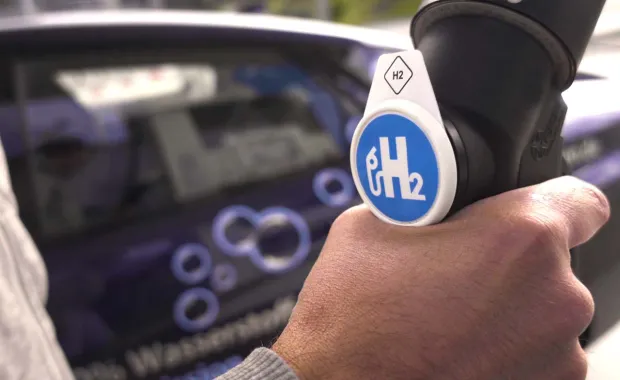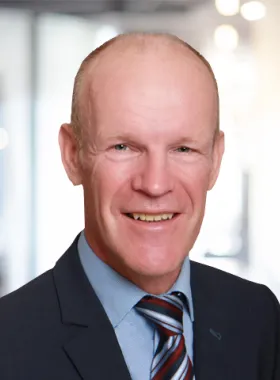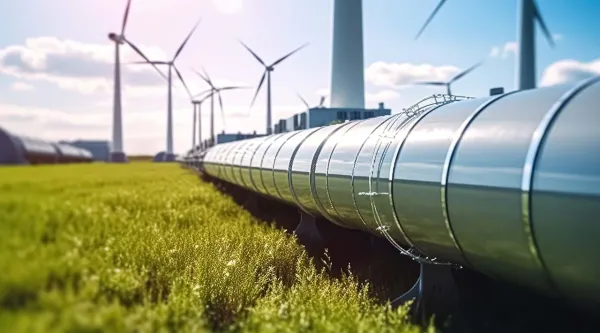Europe is making significant strides in exploring hydrogen's potential to meet ambitious net-zero emissions targets, through a mix of funding, innovation, ecosystem collaboration and strategies. For instance, there are about 35 hydrogen valleys worldwide, of which 24 are in Europe, says Frank. These projects simulate a hydrogen ecosystem, from production and storage to transportation and consumption, to learn about the technology needed and how the value chain could work. "I think this could also be applied in North America as well,” says Frank.
Another example is the European Hydrogen Backbone (EHB) initiative focused on a dedicated hydrogen transport infrastructure across Europe. "There are 31 transport service operators (TSOs) in Europe working on how to transport hydrogen from different suppliers to the industries, which have the biggest need for hydrogen," says Frank. He adds that the war in Ukraine has accelerated efforts to expand the hydrogen pipeline infrastructure from previously set targets.
As data becomes increasingly important, Mark notes North America has invested in data lakes to understand asset performance and build automation on top of those data sets. "These technology and data advances can help make hydrogen technology even more efficient than a couple of years ago," he says. In this regard, sector coupling will become relevant to understanding what is happening across electricity, gas and hydrogen grids. Frank says data is essential to decide when to produce hydrogen or inject electricity or hydrogen into the grid.
Moreover, Frank foresees data lakes becoming more popular. "You have to consider many attributes like the weather forecast, market price, stock market price, demand and supply of hydrogen and other energy sources. You need to work with the data in real-time, and the energy and utilities sector will see a drastic increase in machine learning and data scientists in this area," he says.
In North America, Mark shares that some organizations have been focused on automation for several years to leverage AI and machine learning on their data sets and provide streaming data to operations. "We're also seeing an increase in satellite information to ensure the safety and integrity of pipelines," adding that he expects to see the same trajectory for hydrogen, which will be treated as a new asset.
"At the moment, [in Europe] there's a lot of focus on technology for electrolyzers and fuel cells and to transport and store hydrogen," says Frank. However, he says, some companies have yet to prioritize the technology aspects within their IT landscape how to deal with hydrogen and greenhouse gases (GHG).
Organizations grapple with whether to use their legacy IT systems or something new. Frank recommends clients start with a hybrid IT environment to keep legacy businesses running and have new technologies supporting hydrogen. "Then, in time, shift assets or functions from legacy systems to this new IT so that you will have new IT within 2-3 years."
The shift to a green hydrogen economy takes time, especially as there isn't enough green hydrogen* currently being produced. According to Frank, other technologies like blue hydrogen** and hydrogen from nuclear power will need to be considered in the interim. Decisions need to be made on these alternative options as they each require different types of infrastructure.
Infrastructure is a challenge on both sides of the Atlantic. "If there is no infrastructure, you can't cover demand and supply," states Frank. In North America, Mark says that gas pipelines already cover large distances and can be leveraged. "Various organizations are enabling that kind of pipeline transportation that’s tied quite closely to hydrogen and government is opening investments in that space," he adds.
However, North America's vast geography poses a challenge. Even though infrastructure is being developed and a lot of gas-related infrastructure can potentially be reused, there are many different handoff points. "Lots of collaboration will be needed to ensure it works end to end. Again, [it comes back to] data," he says. Frank agrees that collaboration between organizations and between countries needs to intensify.
However, new technologies mean new costs. But the good news, Mark says, is that in North America, there is already some government funding for certain organizations to speed up this journey.
In Europe, Frank says policymakers are under pressure to develop a hydrogen framework within which companies should operate. "Of course, that impacts investments, and that's why companies investing in hydrogen are demanding policymakers move forward with regulation. The marathon that we talked about three months ago is turning into a sprint," he states. "We also need to have innovative de-risking financing models to move forward," he adds.
The situation in North America is similar, says Mark. The momentum has increased in the last couple of years, driven by a mixture of government intent and funds to achieve their climate pledges and organizations striving to be more sustainable and reach their stated goals.
- Introduction
-
Mark van Engelen:
Hi. Welcome, everybody. My name is Mark van Engelen. I'll be hosting the podcast today, together with Frank. I look after emerging technologies for CGI in Western Canada, and I have a long background in the energy sector, so very excited about our topic today. We're going to be focusing on hydrogen and lessons learned from the European market and how we can apply that to the North American context. So welcome, Frank. Maybe you want to quickly introduce yourself?
Frank Sent:
Yeah. Hello. Frank Sent's my name. I'm acting VP for emerging technologies here in the BU Germany West part of the communications, media and utilities sector.
Mark van Engelen:
Excellent. So, we'll have a discussion today really around kind of the state of hydrogen and maybe getting some lessons learned from what's happening in the European market and see what we can apply. Lots of focus on that in North America, of course. But maybe, Frank, you can start with kind of sharing what's going on with hydrogen in Europe and what do you see as the key activities?
Frank Sent:
Yeah, currently there are 35 hydrogen valleys established. The majority of them are here in Europe, 24 of them. These hydrogen valleys are supposed to simulate the hydrogen ecosystem, the value chain from production, where storage transports to the different means of consumption. That is to learn about the technology, but also how the value chain might work. That is one thing that we see here in Europe establishing more and more.
On the same page, there's the [European] Hydrogen Backbone (EHB) initiative. There are 31 TSOs, transmission service operators, here in Europe working on an idea of the hydrogen backbone, how to transport the hydrogen from the different supplies to the industries which have the biggest need of hydrogen. This has even sped up because of the war in Ukraine. The TSOs understood that they have to be faster, and that their targets for 2030 and for 2040 have to be increased in terms of pipelines that are needed for hydrogen.
Then there are lots of events around hydrogen in Europe. So nearly every week there is something where you can network. And networking is very important because everybody has some different insights into different hydrogen areas.
- Lessons learned from Europe
-
Mark van Engelen:
And that whole understanding of what the infrastructure is and the acceleration is definitely key. What are some of the lessons learned you're seeing from all these kinds of new groups and new focus areas in Europe? What are some pitfalls and lessons learned that we can get from that?
Frank Sent:
One learning is, of course, there's a lot of focus on technology at the moment for electrolyzers, but also fuel cells. Also, the way to transport hydrogen and how to use the different storage facilities. Currently, there's big pressure on natural gas due to the war and getting more independent from Russia. That's why we have to be faster now.
I think one thing that some companies don't put into priority right now is thinking about the IT, how to deal with this new product hydrogen within their IT landscape. And how to deal, not only with hydrogen but also about carbon dioxides which might be captured and stored.
So that is one thing. Then another big area is the regulation, which is not clear yet. It doesn't have to be the same as for natural gas. At least in Germany, there's quite heavy regulation. So certain companies are not allowed to do certain things or do two things in parallel. We don't know yet if that will be the same for hydrogen. Of course, that has an impact on investments. That's why companies investing in hydrogen, big companies like RWE or OGE, they are really demanding politics to get forward with regulation.
- The hydrogen color spectrum
-
Mark van Engelen:
Yeah. So, you see these organizations pushing the boundary a bit and therefore kind of asking or forcing for some of these regulatory changes to get more efficiencies. Do you have an example with one of those clients where we've done some work before and helped in the IT space?
Frank Sent:
Yeah. For example, we discuss blue hydrogen*—so the hydrogen generated from gas, where the carbon dioxide that is created is captured. The question is, do we need that? Of course, everybody is striving for green hydrogen**, so created out of renewables. But, everybody knows that we won't have enough green hydrogen from the start. We might have these kinds of bridging technologies like blue hydrogen to get forward and also to make use of the fuel cells and the rest of the technology. But these decisions have to be taken because then you need different kinds of infrastructure to support this blue hydrogen. These are things where decisions have to be made.
Mark van Engelen:
Yeah. That's where there's quite some value, if I look at the Canadian market, as a lot of that infrastructure already exists for gas and lots of experience in that space. So, I can see why there's the attention for hydrogen and the interest to do that, as well as everybody having their goals for 2030 or 2050 to be aligned to that. So, I agree with you, we strive for green, but realistically, there's going to be a transition period where we're going to have to take some things into account.
Frank Sent:
Yeah. Even the discussion about nuclear power is continuing. In Germany, we basically wanted to get rid of it, but now it's in discussion if we should use that to produce hydrogen—then we have a pink hydrogen, it's partly green. Even though we don't have any solution for the final storage of the nuclear elements, but that is in discussion. So, it’s another area where we need a decision in how to get forward. Of course, that has an impact then on the infrastructure. Currently, the majority of the plan is that the renewables energy is coming from the offshore wind parks or from abroad, from Australia or Africa, where there's enough solar power. But, if we decide to go for nuclear again, then we need different infrastructure to different places.
Mark van Engelen:
I see that as a theme definitely for Europe where there are small nuclear facilities that are looking for a different future, to be able to just leverage that again, looking at existing infrastructure on what you can do. If we can then look at what's happening in North America, we see lots of gas pipelines, etc., already existing for the vast geographies that we have here to cover and being able to leverage a lot of those assets. So, you see various organizations here that enable that kind of pipeline transportation that’s tied quite closely to hydrogen, as well as government opening investments in that space. They do see that as an interesting alternative compared to what's going on today.
- Technology and data considerations
-
Mark van Engelen:
When we look at the IT aspects, which you were talking about before, what are some of the things you're noticing there? Are we using a different type of technology? Do we need to retrofit existing technology?
Frank Sent:
I think most stakeholders have the challenge that they have a legacy IT, which is fit to natural gas over the past 20 years. And similar to telecommunications, this has been growing and growing and it's quite clumsy and it's difficult to update now to the new product hydrogen. Somehow you have to deal with that. Currently, the amount of transactions is quite limited, but it will grow. So, the question from the stakeholders is, do I deal with Excel? Do I use my legacy IT, or do I use something new?
That is where we are coming into the picture as CGI, as we have a very scalable and lean solution that fits perfectly in there. Our strategy, what we propose to clients, is to start with a hybrid IT. So, to run the let's say legacy business and to use our IT to cover the new one, not only hydrogen, maybe also carbon. Then over time, shift assets or functions from legacy to this new IT. Then within a course of two, three years, you might have a new fresh IT.
Mark van Engelen:
Yeah. So definitely leading to some application modernization discussions, understanding the roadmap, the scale, how things are growing, and the data play, right? Where we've got our legacy systems where we capture also ESG-related information. We've got then the potential new applications that look after hydrogen and it still needs to be pulled together somewhere.
I think what I see here in North America anyway, there's a lot of that existing infrastructure, lots of organizations have been investing heavily in things like data lakes and trying to understand their asset performance, trying to build in automation on top of those data sets. I think the timing for hydrogen is good from that aspect. Because it's got a lot of technology advances and data advances it can lean on so we can make the technology even more efficient than perhaps it was a couple of years ago.
Frank Sent:
I mean, we talk also about sector coupling. That becomes more and more important. You need to know what's going on in the other grids—electricity, gas, hydrogen. You need to have vision points for when to produce hydrogen. When it is better to ingest the electricity into the grid or when it is better to produce hydrogen? And for that data is essential.
Mark van Engelen:
Yeah. Lots of opportunities there to do, like you said, cross-sector. I think individual companies are starting to work there, but that kind of data sharing, having that automated connectivity I think is going to be a key part of the future here and hydrogen will be pushing that agenda forward for sure.
Frank Sent:
Yeah.
Mark van Engelen:
So, what do you see as some of the key kinds of evolutions from a technology perspective? Do you see kind of the rise of new platforms, and new SaaS solutions for hydrogen? What do you see happening in Europe?
Frank Sent:
I said the digitalization part is not the priority so far here. It's currently very much about technology. Last week, we have been in Rotterdam for the World Hydrogen Summit. Ninety percent of the exhibitors were technology companies showing the newest trends in technology. Is it fuel cells or electrolyzers and transport and storage in between? Digitalization, we were the only company there working on digitalization and system integration stuff.
But what we see is needed is exactly what we talked about before: having the ability to work with the data that you collected and create the best decisions out of it. Data lakes will become more and more popular. Machine learning is a very important aspect. I mean, you have to take into account so many attributes, like the weather forecast, the market price, the stock market price, and the demand and supply of hydrogen and other energy sources. You need to be able to work with the data real-time. I guess, the energy and utility sector will see a drastic change or a drastic increase in machine learning and data scientists in that area.
Mark van Engelen:
Yeah. Definitely, we see that already here in North America growing. Some organizations are just starting on the journey, some have been on it for several years in order to start to leverage AI/machine learning on their data sets, and start to do more streaming so we can give it back to the operational folks. Also, see the increase of satellite information to make sure the safety of the pipelines and the integrity is there.
We see the same continuing for hydrogen as more of another type of asset with some small changes that would need to take place. They have a lot of good foundations to build on, I think. But they still need to think through it in order to get the advantages. New technology, more costs. There is some government funding becoming available for certain organizations to speed up this journey. So, I think that's a good start. How do you see that in Europe? Where is the industry heading? Is it still heavily kind of government pushed? Or are you seeing organizations seeing the business case themselves to move more towards hydrogen?
- Hydrogen business case drivers
-
Frank Sent:
I think currently, due to the war, the politicians are much more involved and they are under pressure to create the framework. The companies can operate within these frameworks and then guidance is needed. There are investments needed. These investments need to be secured by regulations. Yeah, so I think it's both. But we see that the big companies here, they have already been pre-investing into hydrogen quite a bit. Now everybody's waiting for hydrogen to be really taken up, but this will now be drastically enforced. The marathon, what we talked about maybe three months ago, is turning into a sprint, speed.
Mark van Engelen:
Yeah. No, that's good. Actually, I see something similar here in North America where it's a mixture of kinds of government pushing more and getting more funds allocated just to make sure we hit the goals for 2030 that were set, as well as organizations that have set their own goals, that they want to be more sustainable. They want to be net-zero, etc. I see that definitely over the last kind of year or two, quite some acceleration in that space. For example, CP Rail getting their locomotives hydrogen enabled, that's part of a company's vision and therefore striving towards that with some good collaborations. That again drives the need for more hydrogen. So, we have other asset-type companies that are now wanting to make sure they are part of that supply chain as well. So the drive for 2030 goals or ambition, is changing. I think as you described in Europe, the political environment is accelerating that.
Frank Sent:
Yeah. We saw, for example, in Norway where they heavily invested in the electricity infrastructure to promote electric vehicles, they managed to get to a certain rate of electric vehicles right now. In Germany, this is still lagging behind because the infrastructure is not on the same level and the same applies to hydrogen. If there is no infrastructure, then you can't cover demand and supply.
- The need for collaboration
-
Mark van Engelen:
Yeah. I see that as a challenge here in North America, just because of the geography. But a lot of the infrastructure is being worked on and there's a lot of kind of gas-related infrastructure that can potentially be reused. But it's a big puzzle, right? It's a large geography here, with lots of different handoff points from different organizations. So, lots of collaboration would be needed to make sure that works end to end. Again, data.
Frank Sent:
We have the same challenge in Europe, between the countries, they have to work together now. This has to be established. Networking even has to increase between the TSOs for example, because of hydrogen backbone. Somehow, they have to agree upon their plans and start with adding hydrogen to the natural gas - 10% is possible within the existing infrastructure. And that would already reduce the carbon footprint by 10%. So, there are ways also to get to that number with not too much investment.
Mark van Engelen:
No, that's part of, there's some collaboration here with organizations that want to indeed do up to 20% of hydrogen as part of it. Like I said because there's already lots of gas infrastructure and focus on that. That's a good opportunity to meet the targets or at least get closer to them. Great. Anything else you want to share on kind of Europe and some perspectives and things you think we can learn in North America?
Frank Sent:
As I said, currently the pressure is to get rid of the natural gas and get faster into renewables. I think where does the renewable energy come from has to be answered fast. I mean, we have countries like Denmark or Ireland, which have good ways to produce energy. I think we shouldn't look at a country level only, but in Europe as a total. I mean, especially we in Germany, we are the biggest polluters so to say, we have the biggest carbon footprint due to our heavy industry. We have a lot of needs for hydrogen. I think the same applies to the states, where you have different areas with different focuses and priorities.
So, I think that collaboration is very much needed and infrastructure investments have to be secured. Takeaways from the Wind Meets Gas [Symposium] in 2021 in October that more of the same, meaning hydrogen valleys. These are small ecosystems where we plan and test all the different aspects. I think that is something that could be applied to the states as well. We have to create awareness. I mean, that awareness is now here, everybody in Europe understood it this way. So that has happened I think.
Mark van Engelen:
I agree with you. It's a lot about the puzzling, right, and thinking of a roadmap. For some regions, there may be a lot of water that we can do electrolysis on. In others, there's less water, but there's more sun. So, we may be able to do a kind of green hydrogen there. But how that all works together and how the assets and the infrastructure needs to be able to talk to each other, I think is going to be a key puzzle that we need strong partnerships and collaboration on in order to get the best.
Frank Sent:
One thing that comes to my mind that might be applied as well to North America, we just established a hydrogen hub with the target to use the innovation power from startups and ingest that into their energy and utilities market, use it to foster the hydrogen production. They come up with new ideas that work in the digitalization area quite well. Currently there are not too many hydrogen startups, but we have about 160 to 180 and it helps to increase the pressure on the industry, and also helps them partly to more innovative solutions. And this network we would like to grow at the Europe level. I mean, that could be done across the Atlantic as well.
- Wrap-up
-
Mark van Engelen:
Definitely. Well, great. I think there's lots of opportunity for collaboration. There are lots of technological advances that can be leveraged, but it still needs to be thought through how that applies to hydrogen. You know, how does that relate to the existing kind of asset optimization? How does it link to existing data lakes as well as some of the transactional application systems and modernization that we were talking about earlier? So, opportunities to focus on. I think it will go faster because we have learned so much from the other parts of the energy industry. It's more of a question of how does this apply to hydrogen or how can we make this work for hydrogen versus let's try a new technology or let's figure things out from an IT perspective.
Great. I want to thank you for your time, Frank.
Frank Sent:
Yep. You're welcome.
Mark van Engelen:
Any last thoughts you want to share with us on this podcast today?
Frank Sent:
Yeah. I think that the four major words that will bring the market forward are funding, regulation, innovation, and networking, from my point of view.
Mark van Engelen:
Yeah. Great. Very true. Well, thanks for your time, Frank.
Frank Sent:
Yeah. Welcome.
Mark van Engelen:
And look forward to the next one.
Frank Sent:
Yeah.







